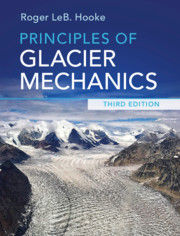Book contents
- Principles of Glacier Mechanics
- Reviews
- Principles of Glacier Mechanics
- Copyright page
- Dedication
- Contents
- Preface to the third edition
- Preface to the second edition
- Preface to the first edition
- Physical constants relevant to ice
- Derived SI units and conversion factors
- 1 Why study glaciers?
- 2 Some basic concepts
- 3 Mass balance
- 4 Flow and fracture of a crystalline material
- 5 The velocity field in a glacier
- 6 Temperature distribution in polar ice sheets
- 7 The coupling between a glacier and its bed
- 8 Water flow in and under glaciers: Geomorphic implications
- 9 Stress and deformation
- 10 Stress and velocity distribution in an idealized glacier
- 11 Numerical modeling
- 12 Applications of stress and deformation principles to classical problems
- 13 Ice streams and ice shelves
- 14 Finite strain and the origin of foliation
- 15 Response of glaciers to climate change
- 16 Ice core studies
- Problems
- References
- Index
15 - Response of glaciers to climate change
Published online by Cambridge University Press: 20 December 2019
- Principles of Glacier Mechanics
- Reviews
- Principles of Glacier Mechanics
- Copyright page
- Dedication
- Contents
- Preface to the third edition
- Preface to the second edition
- Preface to the first edition
- Physical constants relevant to ice
- Derived SI units and conversion factors
- 1 Why study glaciers?
- 2 Some basic concepts
- 3 Mass balance
- 4 Flow and fracture of a crystalline material
- 5 The velocity field in a glacier
- 6 Temperature distribution in polar ice sheets
- 7 The coupling between a glacier and its bed
- 8 Water flow in and under glaciers: Geomorphic implications
- 9 Stress and deformation
- 10 Stress and velocity distribution in an idealized glacier
- 11 Numerical modeling
- 12 Applications of stress and deformation principles to classical problems
- 13 Ice streams and ice shelves
- 14 Finite strain and the origin of foliation
- 15 Response of glaciers to climate change
- 16 Ice core studies
- Problems
- References
- Index
Summary
When the mass balance on a glacier changes, the glacier is prone to either advance or retreat. A number of feedback processes can amplify or suppress the reaction. During the Pleistocene, ice sheets fluctuated in phase with the concentration of greenhouse gases in the atmosphere, but which forced the other is uncertain. Changes in mass balance result in a stable response in accumulation areas and an unstable response in ablation areas. In the latter, stability is restored by the arrival of a kinematic wave from the vicinity of the equilibrium line. Kinematic waves on glaciers move as several times the speed of the ice as a whole, and are subtle in topographic expression. For small perturbations, the response time of a glacier to a perturbation in mass balance can be estimated by dividing the maximum thickness of the glacier by the balance rate at the terminus. This estimate can be improved by taking into consideration the lag between the time the perturbation is felt in the accumulation area and the time necessary to transmit that signal to the terminus.
Keywords
- Type
- Chapter
- Information
- Principles of Glacier Mechanics , pp. 408 - 432Publisher: Cambridge University PressPrint publication year: 2019

